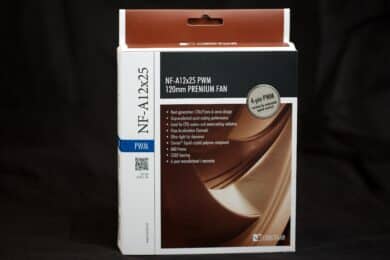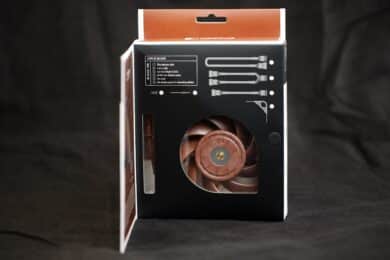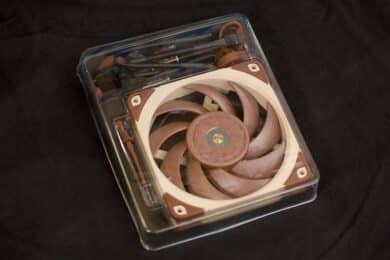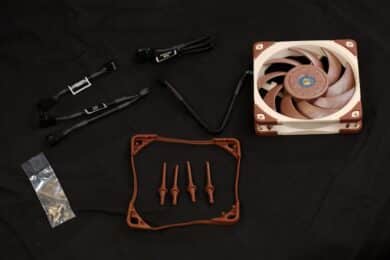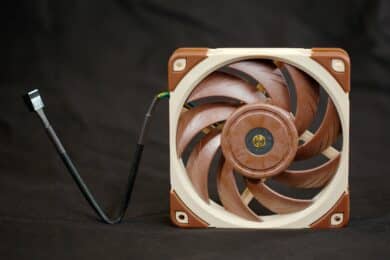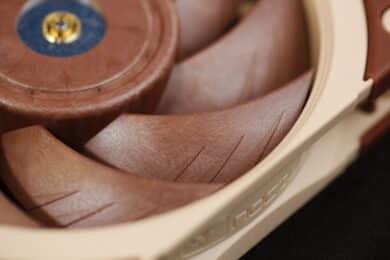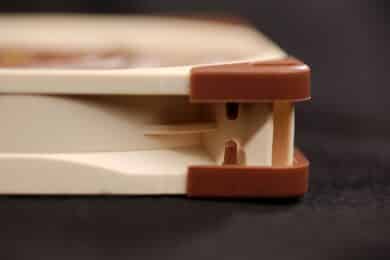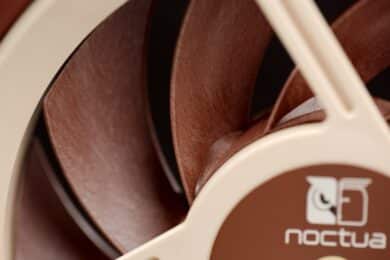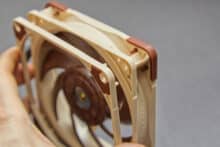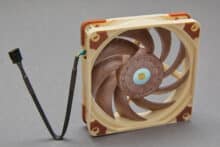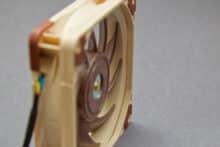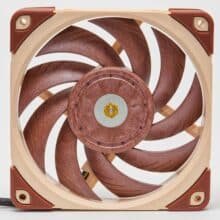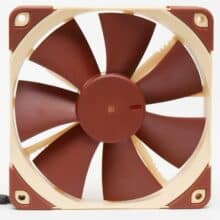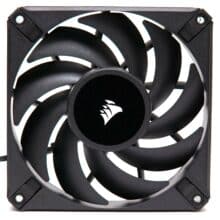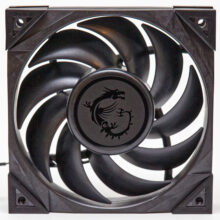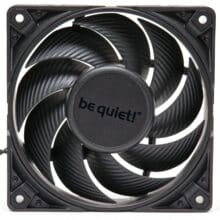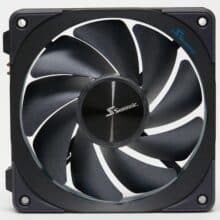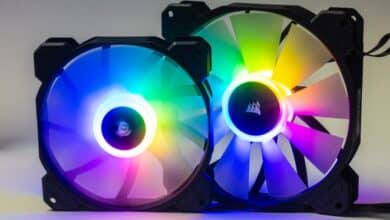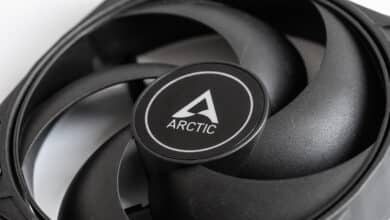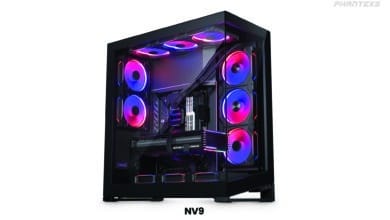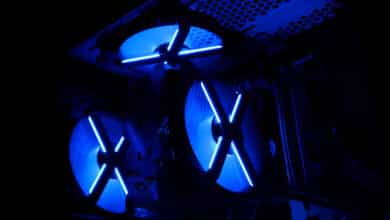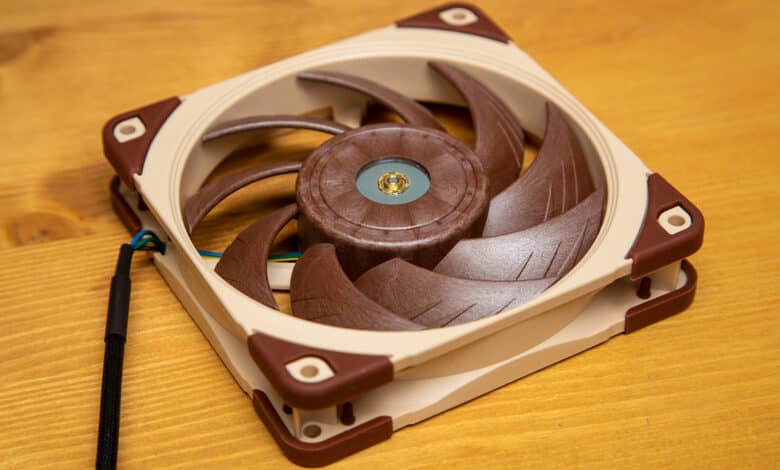
Noctua has long been known for robust, quiet and powerful fans. When the Noctua NF-A12x25 were released in 2018, they created a wave of excitement and they were seen as the ultimate 120mm fans. Many other brands have also adopted design elements of the Noctua NF-A12x25 and incorporated them into newer fans. Now, the NF-A12x25 have been on the market for about five years and the competition has had some time to catch up. So it’s time for an updated Noctua NF-A12x25 PWM review – how well does it do against newer models from other brands?
Specifications
| Dimensions | 120 x 120 x 25 mm |
| Cable length | 20 cm (+ 30 cm extension cable) |
| Rotation speed | 450 (+ / – 20%) to 2000 (+ / – 10%) |
| Maximum airflow | 102.1 m³/h |
| Static pressure | 2.34mm H₂O |
| Material | Sterrox Liquid Crystal Polymer |
| Bearing type | SSO2 (self-stabilizing oil pressure bearing) |
| Expected service life | 150,000 hours |
| Warranty | 6 years |
| Price | € 31.90 * (brown) € 34.90 * (Chromax Black) |
Packaging and scope of delivery
- Secure packaging
- Very comprehensive accessories package included
The packaging of the Noctua NF-A12x25 PWM is typical of the current standard models and are therefore colored brown-white-black. More information about the features, specifications and scope of delivery can be found behind the flaps. This also reveals a view of the fan and a silicone mount. If you now pull out the plastic insert towards the top, you can see that there are really a lot of accessories included. Besides the obligatory fan screws, you’ll find a low-noise adapter, a PWM extension cable, and a Y-splitter. Also, a few silicone parts: Brackets for tool-free case mounting and a sealing ring for use on radiators.
Overall, this is a more comprehensive accessory set than most other fans on the market. More on that later. In addition, the Noctua NF-A12x25 sit above average in their packaging for protection.
Design and workmanship
- The color is not to everyone’s taste, but there is also an alternative black version
- Very high quality workmanship
- Fan blades have a minimal distance to the frame
Yes, the colors of Noctua fans are not everyone’s cup of tea. This wood-colored touch is hard to mix colors with other components. However, the Noctua NF-A12x25 PWM is also available in an all-black Chromax Black version, which is identical in terms of performance and only slightly more expensive.
In particular, the Noctua NF-A12x25 set some new trends, such as the very tapered fan blades at the front, which have since been imitated by many competing brands. The build quality is very high, which you can tell just by touching it. The fan blades in particular are very firm, which is achieved by the liquid crystal polymer. As a result, they were able to keep the distance between the fan blades and the frame very tight. Normal plastic would have the problem here of stretching a bit at higher speeds and rubbing against the frame. But with this hard material, the small distance ensures that you have the largest possible usable area and virtually no air can be deflected back out uncontrolled.
Included accessories
- Y-splitter and extension cable
- Low noise adapter to reduce top speed
- Tool-free housing assembly possible
- Sealing ring to optimize the radiator insert
Sure – Noctua fans are not exactly among the cheapest options. But if you consider what you get here – not to mention the fan quality – as accessories, then the high price is almost put into perspective again. For example, the fan cable on the Noctua NF-A12x25 PWM itself is kept quite short, which is optimal for use on coolers or as a rear case fan to a suitably mounted fan header. But with the PWM extension cable, you can also easily bring it into use as a case or radiator fan if the headers are a bit further away. The Y-cable is also very handy if you have too few headers available on your motherboard and need to bring multiple fans to one connector. For those less familiar with fan control, the low-noise adapter allows you to limit the maximum speed so that the fan doesn’t unschedule into the loudest speed range when the motherboard’s automatic controls escalate.
Silicone mounts can also be found for tool-free installation as case fans, which also dampen any potential vibrations from the fan before they can be transmitted to the case.
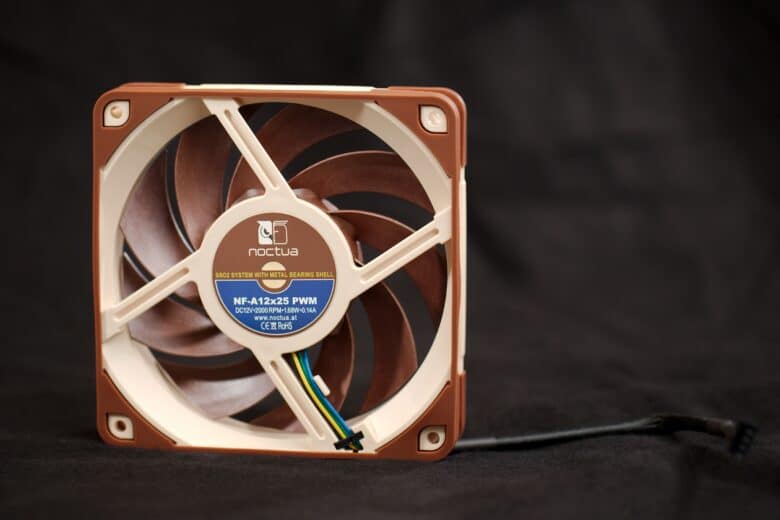
Last but not least, a sealing ring is included in the scope of delivery, which can be exchanged for the factory-mounted corners. These ensure that when mounted on a radiator, no air can escape unused before it has been pushed through the fins.
Optional Noctua accessories
In addition to the accessories already included, the corners of Noctua fans allow for the mounting of other optionally available accessories. Apart from the colored or black Chromax corners, there are here, for example, the NA-IS1-12 spacers, which are available in a double pack. These provide a greater distance to the front grille or radiator in pull configurations, which can reduce noise somewhat.
In a push configuration, these don’t bring any benefits and are therefore only worthwhile in a pull configuration. It’s a bit of a shame that (at the time of testing) you can only get them in a two-pack, rather than individually or as a three-pack for a 360mm radiator. And they are, of course, an additional investment, which in return fits virtually all modern 120 mm Noctua fans.
Comparison fans
- Generous selection of comparison fans from various brands
- Similar price range + / – about 10€
For the test of the Noctua NF-A12x25, we draw on other premium fans in the medium to high price range. For example, the similarly priced be quiet! Silent Wings Pro 4, the even more expensive MSI Silent Gale P12, and the new Seasonic MagFlow 1225 PWM. As a slightly cheaper fan, the Corsair AF120 also ends up in the test. Last but not least, the comparison is made with the Noctua NF-F12 PWM, which are more or less the predecessor model to the Noctua NF-A12x25 and are still available – a good bit cheaper. This makes the test of the Noctua NF-A12x25 PWM very extensive, but as representative as possible.
Test Procedure
- Use as case fan, radiator fan and on tower cooler
- Uniform test procedures
The fans are tested in three situations for performance and volume. Once as a case fan in the DeepCool CH510 Mesh Digital. Then as a radiator fan on an Arctic Liquid Freezer II 240. Last, they go on a DeepCool-AK400 air cooler. In each sequence, the fans are tested at a uniform 1100 RPM, then at a very quiet 31 dB(A), and last at maximum power. All other fans in the system are always set to fixed, low speeds so that the results are not distorted by automatics.
For the case fan test, one of the fans is placed at the bottom front of the case and one at the back. For the radiator test, that of the AIO water cooling is installed in the front of the Fractal Design Pop XL Air and the fans are accordingly also located in the front behind the fan grille and have to overcome the radiator in push configuration as well as the case front in pull configuration. In the air cooler fan test, only one fan is used at a time, whereby the position of the fans is of course always chosen identically.
The results are always adjusted for the room temperature and given as a delta in Kelvin. For this, the temperature fluctuations are calculated out of the measurement results. The current temperature must therefore be added to the results given in the tables. If the table shows a temperature delta of 35 Kelvin and the room temperature is 22°C, the measured temperature will be 57°C. This also means that the lower the results, the better. Low results are, of course, what you want when it comes to volume.
Set as a case fan
Tested at a uniform 1100 RPM
When testing the Noctua NF-A12x25 as case fans, they are very quiet at 1100 RPM, but in terms of performance, they come in last in this comparison – although not by a wide margin. The two loudest fans achieve the best values here.
Tested at 31 dB(A)
At normalized volume, the performance advantage of the louder fans is gone and the MSI Silent Gale P12 take over first place. The Noctua NF-A12x25 are not far behind, but they are obviously not the ultimate case fans.
Test at maximum performance
The maximum power is strongly dependent on the RPM. Accordingly, the be quiet! Silent Wings Pro 4 takes first place. And the previously very good performing MSI Silent Gale P12 are overtaken by the Noctua NF-A12x25 PWM in this test. Overall, they are in the solid midfield.
Used as a radiator fan
Tested at a uniform 1100 RPM
The game is turning on the radiator and the two Noctua fans take the top spots performance-wise. The Noctua NF-F12 PWM are minimally ahead of the Noctua NF-A12x25, but get significantly louder, while the NF-A12x25 are the quietest fans in the test.
Tested at 31 dB(A)
In the test normalized to 31 dB(A), the Noctua NF-A12x25 PWM seem to work their magic. They achieve by far the best performance in this test. They are followed by the be quiet! Silent Wings Pro 3, while the Seasonic MagFlow and the Noctua NF-F12 PWM have to spin drastically slower to achieve the desired low volume, which noticeably affects performance.
Test at maximum power
In test of maximum performance, the be quiet! Silent Wings Pro 4 take first place due to their high maximum speed, but the Noctua NF-A12x25 PWM settle comfortably into second place. The former top models Noctua NF-F12 PWM are very similar in terms of volume, but the speed is much lower in this case, so the performance does not come close to the other fans in the comparison. The quietest fans are the MSI Silent Gale P12, which still perform very well.
Set on the tower cooler
Tested at a uniform 1100 RPM
On the air cooler, the fans sit quite freely and also only one is brought into use. As a result, all of them are quite quiet. Only the Noctua NF-F12 PWM are distinguishable from ambient noise at 1100 RPM. The Seasonic MagFlow 1225 PWM achieve the best temperature.
Tested at 31 dB(A)
Performance shifts when all fans are set to the limit of audibility. This is where the Noctua NF-F12s are dialed down a bit. All other fans can be sped up. The Noctua NF-A12x25 and the be quiet! Silent Wings Pro 4 had the most room to maneuver with the speeds here, and they also achieved the best temperature results. Here, the Noctua NF-A12x25 PWM are now at the top of the test results. The older Noctua NF-F12 PWM are behind.
Test at maximum performance
Similar to the other tests, the be quiet! Silent Wings Pro 4 pulls ahead of the competition in the maximum performance test, while also becoming the loudest. However, they are again followed by the much quieter Noctua NF-A12x25 PWM.
Conclusion
Is the Noctua NF-A12x25 PWM still worth recommending despite its age? Yes, definitely. On radiator and on fan coolers, the Noctua NF-A12x25 PWM’s performance is still unbeatable almost 5 years after its release, putting it at the top of the charts in these areas. It is an amazingly quiet fan that moves air very efficiently. As a case fan, its performance is also good and it works very quietly here as well. Even though a few competing models have now moved past in this application area. Compared to its predecessor NF-F12 PWM, the progress – especially in terms of volume – is clearly noticeable. Sure – it still remains a rather expensive premium fan and the investment is not exactly small if you need several of these fans. As a result, it is and remains a fan for enthusiasts.
Noctua NF-A12x25 PWM
Workmanship
Features
Cooling performance
Noise level
96/100
The Noctua NF-A12x25 PWM are quite expensive, but still deliver incredible performance when used on radiators and air coolers five years after their release.


